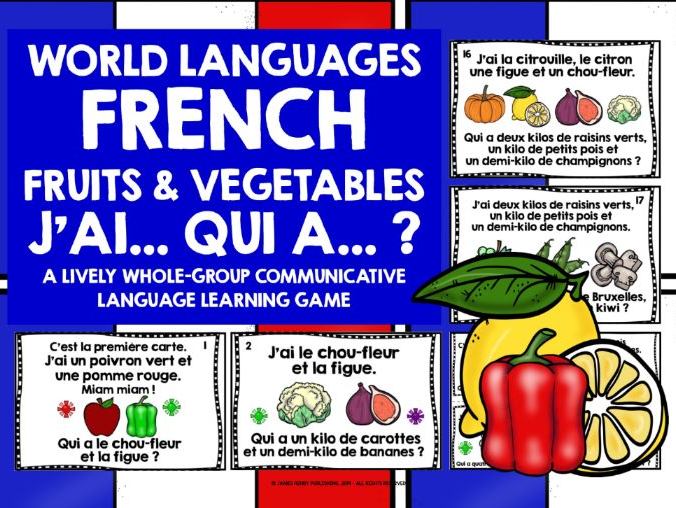PRIMARY FRENCH KS2 FRENCH KS3 FRENCH FRUITS & VEGETABLES FRENCH FOLLOW ME FRUITS ET LÉGUMES EN FRANÇAIS
3 games set @ £1.20 each
Files are non-editable in a zipped format. They are copyright, all rights reserved. They may not be copied, rewritten, shared or distributed outside your own classroom in any way. The license for purchase is a single-user license only. Please read the Terms of Use carefully.
The games feature a range of fruits and vegetables in French:
Set 1: focus on French fruits
Set 2: focus on French vegetables
Set 3: focus on a combination of both French fruits and French vegetables
I have, Who has? J’ai… Qui a… ? is a whole-group lively & communicative language learning game, perfect for practising, reinforcing & refreshing French target language.
The game has a multi-skill focus: listening, speaking & reading, with an important bonus focus on social interaction and participation. The game is perfect for pronunciation practice too - particularly with silent s, the non-/audible sound of x (deux and dix for example) and so on.
I point out particular phonemes and sounds too - such as the ch in champignons, the soft c in citron compared to the hard c in carotte , the eu in chou-fleur and the ei in groseilles.
The aim of the game is to create a French sentence chain as quickly as possible, starting with J’ai la première carte, and ending with the final card, C’est la dernière carte. The game also works well if the sentence sequence is placed on the floor, a longish table, or other flat surface. I created the game for my young beginner French learners, but I’ve also played the game with my older adult French learners, who really enjoy it too.
The design is four cards per page, which allows for a large font, which is really important for beginner language learners who are familiar with the written word, and starting to link spelling with sound. Try to print in color if you can - it adds to the visual appeal of the game, which is a real motivator for learning.
I always laminate my games cards, which is definitely worth the extra prep time and additional expense - the cards are far more learner-friendly, and last in excellent condition for years, so I get lots of use from them.
There are 29 fruits featured in the games: green apple; red apple; banana; cherry; date; fig; gooseberries; grapefruit; green grapes; red grapes; honeydew melon; kiwi; lemon; lime; mango; nectarine; olive; orange; papaya; peach; pear; pineapple; pumpkin; raspberry; redcurrants; rhubarb; starfruit; strawberry; watermelon.
with 28 vegetables: artichoke; asparagus; aubergine; green beans; beetroot; broccoli; Brussels sprout; cabbage; carrot; cauliflower; celery; cucumber; garlic; leek; lettuce; mushroom; onion; peas; green pepper; red pepper; yellow pepper; potato; sweet potato; radish; spinach; sweetcorn; tomato; zucchini.
All the fruits and vegetables may not be in my longer-term learning plan, but the learning objective moves beyond simply learning individual units of vocabulary. The images help students infer meaning from context, supported by the visual prompts and clues. This in turn supports them in developing their French language skills in the longer and more complex sentences.
There is implicit input on grammatical concepts such as adjectival agreement, gender, definite, indefinite and partitive articles and position of adjectives, either preceding or proceeding the particular noun. This is a very successful way of really getting the most of what looks like a straightforward game for consolidating the target vocabulary - it is actually so much more!
The question card template provides an additional learning activity, with students applying their developing French language knowledge creatively and practically, as they make game cards for the class. This is*** integral to successful language learning***, and it’s actually a really popular activity with my students. They read their new sentences to the whole class, and it’s generally a competition to see who can create the longest sentences with the most fruits.
Download, print out, laminate, cut out & shuffle the cards. Distribute the cards, one or two per student, depending on how many students you have in your group. I often play too - students really do enjoy it when I join in, and they seem to work that little harder on their concentration, reading out loud and pronunciation. Students walk around the room, talking to each other in their best French accent, sharing the information on their cards, until they have arranged the cards in the correct order. The game is also really successful when we play in teams against a timer, regularly over a longer-term series of lessons - students love to see if they can beat their own time record, as well as the other teams. The competitive element is a great motivator for learning too.
Have a browse in my store for more French J’ai… Qui a… ? games, and a wide range of other French teaching and learning materials, with French resource boxes special offer bundles and lots of freebies - I’ve included a couple here for you to try.
MERCI BEAUCOUP ET BON APPRENTISSAGE !
Something went wrong, please try again later.
This resource hasn't been reviewed yet
To ensure quality for our reviews, only customers who have purchased this resource can review it
Report this resourceto let us know if it violates our terms and conditions.
Our customer service team will review your report and will be in touch.






